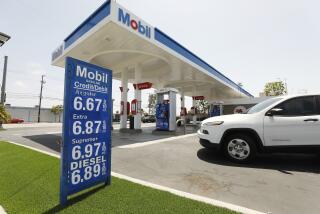Cutting Gas Taxes Will Make Things Worse
In the debate over gasoline price increases, American politicians fail to grasp that the global oil supply picture is soon to change, permanently and with wrenching effects for the unprepared.
For the past 50 years, oil companies, geologists, governments and independent researchers have been estimating how much recoverable oil remains in the Earth’s crust. The consumption pattern for oil--or any nonrenewable resource--follows a fairly symmetrical bell-shaped curve. Peak and decline are inevitable and can be estimated fairly accurately, and at the peaking point prices will start to rise.
Today’s price spike doesn’t mean that we are at that turning point now any more than the oil price shocks of 1974 and 1979 did. But more than 40 studies published since the early 1950s show a remarkable consensus among petroleum experts worldwide on how much oil ultimately will be recovered. That fateful day when prices will begin to rise permanently is now within sight.
Experts believe that between 1,100 billion and 1,500 billion barrels of recoverable oil remain in the ground. Considering that annual consumption is only 22 billion barrels and that cumulative consumption from the 1850s to the end of 1995 was about 765 billion barrels, that amount sounds huge. But given the not very daring assumption that demand will rise by 2% a year as populations and economies grow, oil production will not be able to keep up with demand beginning between 2007 and 2014.
Estimates of total recoverable oil weren’t wildly different two decades ago, when the first oil shocks sent lines around the block and prompted Detroit to get serious about automotive fuel efficiency. But for three reasons, the big picture has changed.
First, with oil prices high from around 1975 through 1985, exploration increased dramatically. Yet no major new fields were found anywhere. Geologists have a good understanding of where to look for oil and few expect any giant new fields to be discovered.
Second, the massive, self-reported oil reserves of the Organization of Petroleum Exporting Countries may be greatly overstated. The Oil & Gas Journal reports proven reserves in 1995 of about 1,000 billion barrels, two-thirds in the Persian Gulf. But in the early and mid-1980s, proven crude oil reserves ranged between 650 billion and 700 billion barrels. What happened here? Beginning in 1985, OPEC members began reporting huge increases in their reserves: 41% in Kuwait; 50% increase in Saudi Arabia; 100% in Iran, Iraq and Venezuela; 200% in Abu Dhabi and Dubai. Industry insiders classify these mammoth increases as “political reserves”--related more to OPEC quota negotiations than to new finds. The 300 billion barrels of “political reserves” have remained exactly the same year after year, a fish-and-loaves story considering how much oil these countries have exported since 1985.
Third, the first and second decades of the 21st century seemed light years away 20 years ago, but now many of us have mortgages that will last longer than the day of petroleum reckoning. Now we have 10 to 15 years to reengineer our transportation sector to depend less on oil. Even champions of electric vehicles and other alternatives to petroleum-powered mobility admit this will be difficult.
Meanwhile, dependence on OPEC is growing. In 1995, OPEC accounted for about 41% of world oil supply. By 2010, OPEC’s share could reach 53%, essentially the same as in 1973 during the Arab oil embargo. In 1973, the United States imported 5% of its oil from the volatile Middle East. Last year it was 9%.
Cutting gas taxes would discourage the use of electric or other alternative-fuel vehicles and promote wasteful and dangerous driving habits at high speeds. (At 75 mph, your car uses 50% more fuel than it does at 55 mph.) Reaching a bipartisan consensus on national energy goals is a lot harder than buying votes at the gas pump. But since declines in the real price of gas trigger more pollution, greenhouse gas emissions, sprawl, congestion and import addiction, it’s worth a try.
More to Read
Sign up for Essential California
The most important California stories and recommendations in your inbox every morning.
You may occasionally receive promotional content from the Los Angeles Times.










